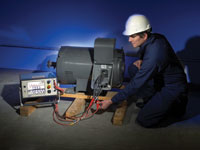
Posted to News on 18th May 2016, 00:00
Static motor testing improves reliability
Making static or insulation testing a larger part of the predictive maintenance regime could help to avoid a large number of failures in electrical motors, explains Michael Herring of SKF.

The most common cause of electric motor failure, accounting for around 40 to 50% of cases, is a problem with the bearings. After this, around 30% of failures are caused by insulation problems within the motor. However, while predictive maintenance (PdM) techniques such as vibration analysis are commonly used to analyse bearing health, similar methods are rarely used to detect insulation failure. Problems caused by insulation weakness can be just as serious as those caused by worn bearings or overheating. For this reason, it is equally important to assess insulation strength – and take action in good time. This is done using insulation (or static) testing.
Here, the motor is disconnected from its power supply and put through a range of tests to identify internal problems. It is typically tested from the motor control cabinet, which ensures that electrical faults outside the motor itself – such as in junction boxes or external cables – are picked up. There are five main types of static test, which are performed in a specific order:
- Winding resistance
- Meg-ohm test
- PI test
- DC step voltage test
- Surge test
Motor testing has traditionally been carried out using a resistance meter and a Meg-ohm meter (or ‘megger’) but these tests have limitations in finding all potential fault modes. The Meg-ohm test can show if the motor has a dead short to earth, or is wet or contaminated. It can determine if a motor is bad, but this test alone cannot confirm that it is good. While low Meg-ohm results indicate moisture, contam-ination or impending failure, high meg-ohm results do not necessarily indicate that a motor is free of other faults.
A Polarisation Index (PI) test takes 10 minutes, and incorporates the 1-minute Meg-ohm test. It is expressed as the ratio of the 10-minute meg-ohm value divided by the 1-minute value – with a value of 2 generally taken as acceptable. The PI test is mainly used on high voltage motors, to measure the ability of an insulator to polarise. It can confirm poor or degraded insulation within a motor and whether the insulation is brittle, but will not find potential copper-to-copper faults.
The DC step voltage test is typically performed at twice the line voltage, plus 1000V. Voltage is increased in five or more steps, and leakage current is plotted. Good insulation will show a linear plot, while insulation weakness can be revealed by non-linearity.
The Surge test is typically the last one to be performed, and determines turn-to-turn, coil-to-coil and phase-to-phase insulation condition. It injects fast rise time voltage pulses into each phase and analyses the resultant sine waves. Changes in waveform frequency during the surge test indicates winding insulation weakness, which is an early warning of impending failure.
Static test results are clear and unambiguous, and produce a specific result that requires little interpretation. A step test, for instance, provides a meg-ohm value that will lie within or outside pre-set limits; and, for the surge test it indicates a percentage variation between pulses or phases, indicating the level of insulation weakness. As well as giving a clear output, results can be trended over time, which helps operators or maintenance managers assess the progress of a potential condition.
Increasingly, tests are being carried out by automated test equipment, such as the SKF Baker AWA-IV. This helps to remove operator error and inconsistency caused by issues such as different operators using different test parameters, or applying a different test sequence to the motor. The tests may seem simple, but they can have a huge effect on productivity and maintenance. One pulp and paper company has a plant with 800 motors – aiming to test each one twice a year.
It began using SKF Baker AWA-IV testers to perform these tests, which helped it to cut its annual motor costs by nearly one-third. Among the many problems it found – and solved – were:
- Blown holes in insulating boots that covered cable lugs in junction boxes, flagged up by a step voltage test
- A bad lug connection in the motor junction box, found after it failed a resistance test
- A stator coil turn-to-turn short on a booster fan, identified by a surge test
- A cable shorted to ground in starter, and a pinhole in the cable, found after it failed the surge test and step voltage test.
Furthermore, these tests can reveal ‘hidden’ problems that other tests miss. A steel mill in Australia sent a 6.6kV pump motor for repair, which included rewinding and a second operation to encase the windings in insulating varnish using vacuum pressure impregnation (VPI). Prior to running up the motor, a surge test indicated that the insulation strength was suspect, even though motor currents were OK during running and other tests (such as vibration monitoring) showed acceptable results.
The mill was in a hurry to resume production, so put the motor back into service – but it failed after three days. The reason was traced to the windings, which had probably been damaged in transit to or from the VPI facility. The surge test identified the problem, but had been discounted.
Proof, if it were required, that automated static testing produces solid results and can deliver real savings – as long as the results are heeded.








